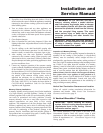
Installation and
Service Manual
17
3. If possible, close all building doors and windows. Close all
doors between the space in which the appliances remaining
connected to the common venting system are located and
other building spaces.
4. Turn on clothes dryers and any other appliances not
connected to the common venting system. Turn on any
exhaust fans, such as range hoods and bathroom exhausts,
so they will operate at maximum speed. Do not operate a
summer exhaust fan.
5. Close fireplace dampers.
6. Place in operation the unit being inspected. Follow the
lighting instructions. Adjust thermostat so unit will operate
continuously.
7. Test for spillage at the draft hood/relief opening after
5 minutes of main burner operation. Use the flame of a
match or candle, or smoke from a cigarette, cigar or pipe.
8. After making sure that each appliance remaining
connected to the common venting system properly vents
when tested as above, return doors, windows, exhaust fans,
fireplace dampers and other gas burning appliances to their
previous conditions of use.
9. Correct any improper operation of the common venting
system so that the installation conforms to the latest edition
of the National Fuel Gas Code, ANSI Z223.1, in Canada,
the latest edition of CAN/CGA-B149 Installation Code for
Gas Burning Appliances and Equipment. When resizing
any portion of the common venting system, resize to
approach the minimum size as determined using the
appropriate tables of the latest edition of the National Fuel
Gas Code, ANSI Z223.1, in Canada, the latest edition of
CAN/CGA-B149 Installation Code for Gas Burning
Appliances and Equipment.
Masonry Chimney Installations
A masonry chimney must be properly sized for the installation
of a high efficiency gas-fired appliance. Venting of a high
efficiency appliance into a cold or oversized masonry chimney
can result in operational and safety problems. Exterior
masonry chimneys, with one or more sides exposed to cold
outdoor temperatures, are more likely to have venting
problems. The temperature of the flue products from a high
efficiency appliance may not be able to sufficiently heat the
masonry structure of the chimney to generate proper draft. This
will result in condensing of flue products, damage to the
masonry flue/tile, insufficient draft and possible spillage of
flue products into an occupied living space. Carefully inspect
all chimney systems before installation.
Inspection of a Masonry Chimney
A masonry chimney must be carefully inspected to determine its
suitability for the venting of flue products. A clay-tile-lined
chimney must be structurally sound, straight and free of
misaligned tile, gaps between liner sections, missing sections of
liner or any signs of condensate drainage at the breaching or clean
out. If there is any doubt about the condition of a masonry
chimney, it must be relined with a properly-sized and approved
chimney liner system. An unlined masonry chimney must not be
used to vent flue products from this high-efficiency unit. An
unlined chimney must be relined with an approved chimney
liner system when a new appliance is being attached to it.
Metallic liner systems (Type-B double-wall or flexible or rigid
metallic liners) are recommended. Consult with local code
officials to determine code requirements or the advisability of
using or relining a masonry chimney.
Vertical Vent Termination Clearances and Location
Follow all vertical venting termination information for
clearances and location under Vertical Vent Termination
Clearances and Location, page 11.
2. Vertical DirectAire™ Venting
The Vertical DirectAire™ vent system is the same as the
Conventional Negative Draft vent system, except it pulls
combustion air from the outdoors through a vertical air inlet.
Follow all requirements in 1. Conventional Negative Draft
Venting, page 16.
IMPORTANT: Before installing the venting
system, follow all venting clearances and and
requirements found in the Venting, General
Information section, page 11.
ƽ WARNING: Do not vent this unit into a
masonry chimney without a sealed stainless
steel liner system. Any breaks, leaks, or damage
to the masonry flue/tile will allow the positive-
pressure flue products to leak from the chimney
and into occupied living spaces. This could
cause serious injury or death due to carbon
monoxide poisoning and other harmful flue
products.
IMPORTANT: Check with local code officials to
determine code requirements or the advisability
of using a masonry chimney with a sealed
corrosion-resistant liner system.


















